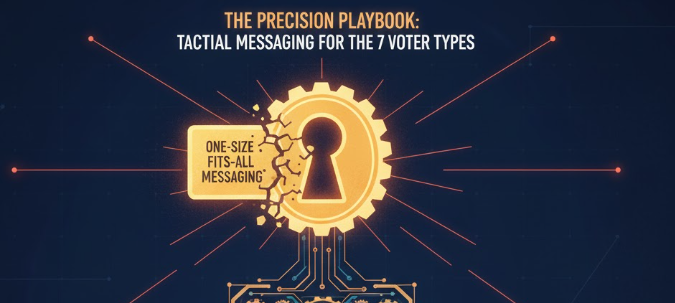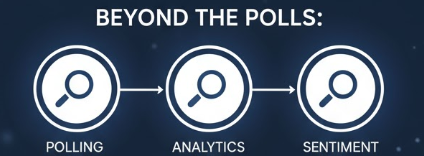Modern campaigns are abandoning one-size-fits-all messaging for a precision strategy that targets seven distinct voter archetypes by tone and channel.
What to Know
- "One-size-fits-all" messaging has failed and is being replaced by precision targeting based on behavioral archetypes.
- Signal Boosters are targeted on X and Truth Social with "red meat" to generate volume, not persuasion.
- Cultural Contrarians and Backlash Parents are activated by urgent, emotional triggers on platforms like podcasts and local Facebook groups.
- Silent Resistors are reached offline via high-trust networks like text and local peer groups, not with political ads.
- Attention Undecideds are targeted last with high-budget TV and mail, focusing on single issues like gas prices or crime.
The era of running one general election message on broadcast television is over. Modern campaigns recognize that the electorate is not a single bloc but a collection of distinct behavioral segments. GOP data strategist Chris Wilson first popularized this idea through his Seven Voter Types framework, which redefined how campaigns think about persuasion, sentiment, and activation. His model shifted the focus from demographics to behavior and emotion, laying the foundation for today’s precision playbook.

Image by DALL-E
This new strategy messages with precision, moves with timing, and monitors emotion. It understands that each of the seven voter types requires a completely different trigger, a unique tone, and a specific path to conversion. Using the wrong message on the wrong channel is not only ineffective but also counterproductive. It is a waste of a campaign's two most valuable resources: time and money.
Volume and Backlash
Campaigns must first energize their most loyal segments. Signal Boosters are the primary target for amplification. They are not persuadable. They require a "red meat, identity-affirming" tone delivered through platforms like X (formerly Twitter) and Truth Social. For this group, success is not measured in minds changed but in "meme velocity" and message volume.

Images by Gemini
Cultural Contrarians are mobilized by backlash. They are defined by what they oppose. Campaigns reach them with "anti-elite, non-PC, and humorous" content on podcasts, X, and Telegram. They activate when mainstream media frames an issue as extreme. The correct campaign response is defiance, not a polished rebuttal.
Parents and Narratives
Two key groups are activated by sudden, emotional spikes. The Backlash Parent moves from passive to active almost instantly. They are targeted with a "protective, urgent, family-first" tone. The key channels are not national news but local platforms: Facebook groups, local news segments, and school board meetups. Campaigns monitor sentiment spikes around keywords like "my kid" or "unsafe" to know when to engage.

Image by DALL-E
Narrative Converters require "story-driven, emotion-first" content. They absorb new viewpoints after elites and media have framed them. Campaigns target them on visual platforms like YouTube and Facebook Watch. The key signal of a shift is when this group begins sharing new headlines that reflect the campaign's desired narrative.
Resistors and Tribalists
Not all voters are won with aggressive messaging. The Silent Resistor is often a "shy voter" who avoids polls and public political debate. They are repelled by overt politics. Campaigns must use a "respectful, values-based" tone. The most effective channels are high-trust and offline: text messages from known numbers, door-to-door canvassing, and micro-surrogates in local networks like churches and PTAs.

Image by DALL-E
Similarly, the Reluctant Tribalist resists outrage. They want "permission" to vote for a candidate. They require a "calm, rational, competent" tone that avoids sarcasm. They are reached through intellectual or professional channels like op-eds, LinkedIn, and long-form email newsletters.
The Final Mile
The final group to target is the Attention Undecided. These are low-information voters who act like consumers. They require "emotional clarity" and a focus on a single, tangible issue like gas prices, crime, or jobs. They are not reached early.

Image by DALL-E
Campaigns reserve high-budget resources like direct mail and broadcast TV for the final weeks to win this group. Key metrics include tracking Google Trends to see when they finally start searching for these issues.
Wrap Up
The shift from demographic targeting to behavioral targeting is no longer a trend. It is the new campaign standard. Victory now depends on operations that are agile, data literate, and emotionally aware, able to read and respond to voter sentiment in real time. Campaigns that still blast one generic message to “suburban women” are already behind. Those that can tell the difference between a Backlash Parent and a Reluctant Tribalist in the same zip code can reach both with precision and win.
As Chris Wilson first argued in his Seven Voter Types framework, the future of political persuasion lies in understanding how people think and feel, not just who they are on paper. As we move toward 2026 and beyond, the fragmentation of media and the erosion of trust in traditional institutions will only accelerate. The ability to identify these seven archetypes, monitor their emotional triggers, and activate them on their preferred channels is no longer an innovative edge. It is the baseline for victory.





